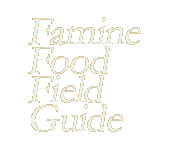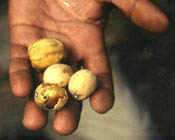| Click on the four categories above
to access the species listings of wild-food plants in Ethiopia, giving
a general description and information on edible parts, preparation methods
and palatability. For information about how to use the Field Guide, click
on the instructions button on your left.
General description and classification
of comestible wild plants: 'wild-food' and 'famine-food'
'Wild-food'
The term 'wild-food', though commonly
used, is misleading because it implies the absence of human influence and
management. In reality, there is a continuum resulting from the development
of co-evolutionary relationships between humans and their environment (Bell,
1995). People have indirectly shaped many of the plants and some have been
largely domesticated in home gardens and in the fields together with farmers'
cultivated food and cash crops. Nevertheless, the term 'wild-food' is used
to describe all plant resources outside of agricultural areas that are
harvested or collected for the purpose of human consumption in forests,
savannah and other bush land areas. Wild-foods are incorporated into the
normal livelihood strategies of many rural people, be they pastoralists,
shifting cultivators, continuous croppers or hunter-gatherers (Bell, 1995).
Wild-food is usually considered as an additional diet to farmers' daily
food consumption pattern, generally based on their crop harvest, domestic
livestock products and food purchases on local markets. Fruits and berries
from a wide range of wild growing plants are typically referred to as 'wild-food'.
Wild fruits and berries add crucial vitamins to the normally vitamin deficient
Ethiopian cereal diet, particularly for children.
'Famine-food'
Various case studies in different
parts of Ethiopia revealed that typical 'famine-food' consists of a variety
of plants of which leafy and tender parts of stalks, pseudo-stems, fruits,
berries, seeds, husks and roots, i.e. tubers and corms are mainly used
for consumption. Plants classified as typical 'famine-food' plants are
normally not consumed due to their limited seasonal availability, local
taboos, offensive nature of the plants such as abundance of thorns and
tiny spines (mostly not on the edible part of the plant), certain unpleasant
characteristics and side-effects such as bad taste, complicated and prolonged
preparation, and association with stomach complaints, constipation, diarrhoea
and even intoxication. On the other hand, certain 'wild-foods' which are
liked and therefore collected and consumed every time when ripe, may also
become very important 'famine-foods' during periods of food shortage. In
certain areas of Southern Ethiopia some potential 'famine-food' is well
known as livestock fodder during normal times which will also be consumed
by humans at times of severe food shortages.
Proposed 'wild-food' plant categories
Depending on the parts of the plants
(fruits, leaves, roots etc.) consumed in certain circumstances (normal
time versus period of severe food shortage) by different consumers (adults,
children, women, men), four major categories of 'wild-food' plants can
be distinguished: (1) typical 'famine-food' plants, (2) 'wild-food' plants
with 'famine-food' components, (3) 'wild-food' plants attracting additional
consumer categories during food shortage periods, and (4) on-farm food
crops with 'famine-food' components. Each category and some typical representative
examples of 'wild-food' plants are described below.
Back
to top
|



